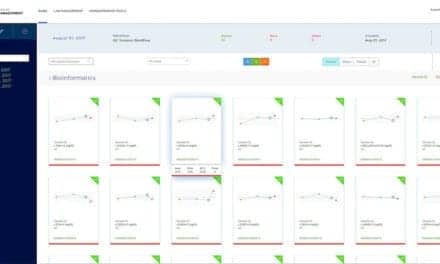Molecular biology company 10x Genomics, Pleasanton, Calif, has begun shipping its Visium spatial gene expression solution. The Visium platform for spatial molecular profiling enables researchers to see how cells are organized in relation to one another, allowing for a deeper understanding of biological systems in both normal and disease states. The solution gives researchers a comprehensive map of where gene activity is occurring in a tissue specimen.
The Visium spatial gene expression solution is the first new product to result from 10x Genomics’ acquisition of Sweden’s Spatial Transcriptomics.
“When we acquired Spatial Transcriptomics last year, it was with the belief our two teams could improve the resolution, scale, and workflow in spatial genomics to rapidly accelerate our understanding of biology,” says Michael Schnall-Levin, PhD, senior vice president of research and development and founding scientist at 10x Genomics. “This announcement furthers our commitment to enable existing and new researchers in their work, and opens new areas in molecular pathology that were not possible before.”
The Visium platform represents a significant improvement in resolution for spatial molecular profiling. The solution offers scientists in many areas of biology, including oncology and neuroscience, the following:
- Ability to survey hundreds of thousands of cells in a tissue section simultaneously using total mRNA spatial gene expression analysis.
- Five times more spots within a capture area (5,000) than the prior offering from Spatial Transcriptomics, allowing researchers to map gene expression to tissue architecture with high spatial resolution.
- Reduction in the time involved to perform an assay from 3 days to 1 day over the previous offering.
- Extremely high sensitivity, capable of yielding at least 100,000 unique molecular identifiers and thousands of genes per spot.
- Intuitive software for automated processing of Visium data as well as streamlined data analysis tools for both bioinformatics novices and experts.
- The only comprehensive kitted solution available on the market allowing researchers to perform gene discovery from total mRNA analysis.
“Spatial genomics opens up new possibilities for bringing microscopic anatomy into the realm of RNA sequencing,” says Daniel Weinberger, MD, CEO of the Lieber Institute for Brain Development. “Visium makes it possible to spatially resolve gene expression in a complex cytoarchitecture through an end-to-end fully kitted solution with turnkey software and no need for capital equipment investment. Scientists at the Lieber Institute for Brain Development running samples through the Visium solution have produced incredibly detailed results on the human brain that we did not think were possible.”
“The rich spatial transcriptome maps produced by Visium will add another dimension to the growing single-nuclei and single-cell RNA-seq datasets to spatially refine the cell types in the human brain and their subsequent dysregulation in debilitating brain disorders,” says Andrew Jaffe, PhD, lead investigator at the of the Lieber Institute for Brain Development.
“We believe this technology answers important questions in neurology and neuroscience,” Weinberger adds, “and could also reveal novel molecular insights into other common human diseases with abnormal pathology.”
For more information, visit 10x Genomics.
Featured image: A coronal mouse brain section with overlaid spatial gene expression information. The spots correspond to localized mRNA of the hippocalcin protein coding gene Hpca, which is known to have predominant hippocampal expression. Image courtesy 10x Genomics.




